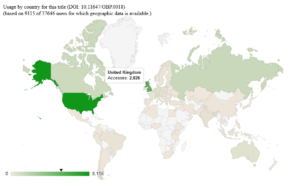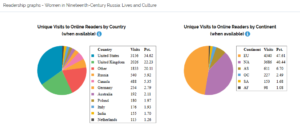Open Access Around the World: Tracking Our Books Using Online Statistics
At Open Book Publishers, openness is at the heart of everything we do (the clue is in the name!) Recently, we’ve been working on how to present more data about our books on our website, in a more visually attractive way. We want to know as much as we can about how many times our books have been downloaded and accessed, and where in the world they’re being read – and we want you to be able to see this information too. It’s all part of our mission to make the case for Open Access by showing the reach a book can have when it’s made freely available online for everyone to read. (For a more in-depth look at what the numbers reveal about the impact OA publishing can have, read our blog post from July 2017.)
Before getting into the numbers, a note about privacy: we’re interested in knowing how much our books are being used, but we don’t want to infringe people’s privacy by tracking who is using them. We discard any personal information that could identify individuals, thus we only know if a book has been accessed, and in some cases (if the individual allows it) we know what country it’s been accessed from, but we don’t know who has accessed it.
On each book’s webpage it has always been possible to see the number of times the book has been accessed online, and to view a map showing some geographical information about the readership (for more information about how we collect these statistics, click here):

Now, however, this information is available in much more detail, for both online views and PDF downloads, broken down by platform, by year, and (if you click on a particular year) by month:


You can still view the map that shows reader location for all the users who allow us to track this:

But now you can also see the whole dataset presented in colourful graphs:

Online readership and download data is available for every title, and sales data is also available if authors or editors choose to make it public. This allows us (and you!) to see in much more detail how frequently, when, where, and how our readers are accessing our texts. It’s a wealth of information to sift through (and we encourage you to do so if you’re interested – and let us know what you find). Here are a few stand-out facts:
- All our books, with the exception of the four most recent at the time of writing, have been accessed from all inhabited continents (i.e. not including Antarctica).
- All our books reach all (inhabited) continents within a year after publication (most of them in less than 6 months).
- Information and Empire: Mechanisms of Communication in Russia, 1600-1850 has been accessed more in Russia than anywhere else.
- Storytelling in Northern Zambia has been accessed more in Zambia than anywhere else.
- Peace and Democratic Society is the book that has been accessed in the highest number of countries and territories (183), and it’s the second most read in Africa (the first in Asia, where readership is particularly high in the Philippines).
- During the first month after its publication, Tolerance was accessed over 12,000 times.
With these figures and others like them we can show, more clearly than ever before, the potential reach of Open Access publishing.



